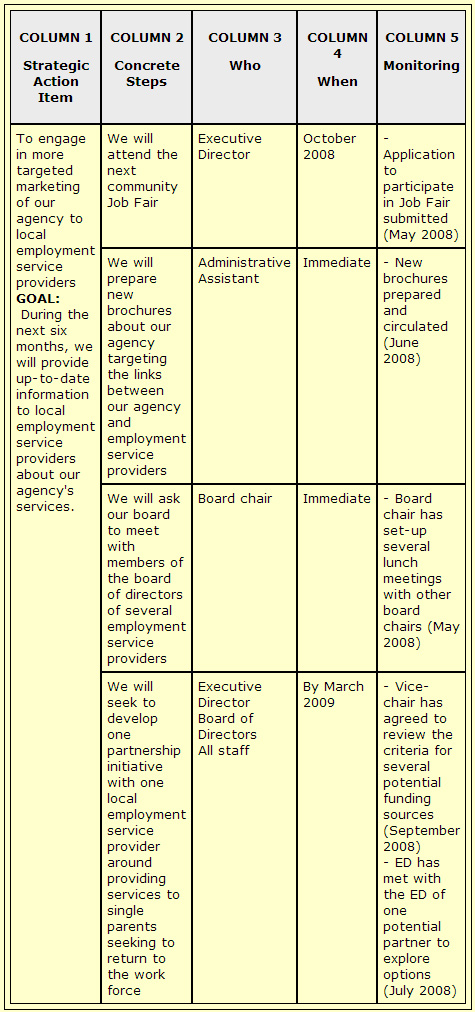 Monitoring
Monitoring
Tracking implementation of your plan
The fifth and final step in strategic planning is monitoring implementation. In this step, what you are seeking to find out is: how are we doing?
Once you have completed your strategic plan, don’t put it away in a drawer someplace! It should stay open and handy because it is your agency’s primary tool for day-to-day actions and decisions. It is meant to be used on a regular basis. Here are some tips for ensuring that this happens.
You have already set some target dates for particular actions to be carried out.
- Write those dates and actions into your year-at-a-glance calendar or put them on a large wall calendar where everyone can see them.
- Make it a habit to quickly review the plan monthly. On the last day of each month, take note of the action items that must take place during the next month.
- On the strategic plan, in the final column called “monitoring”, make brief note of progress made towards achieving goals and actions taken. This provides a running, up-to-date record of steps taken and progress made.
- To provide an update to key stakeholders, simply print off the up-to-date strategic plan showing the ever-growing list of completed actions. You only ever need to work with one document; you do not have to have several versions or copies. By the end of the year, you will have a full record of progress made and this information can be used to set new goals for the future and to report on successes you have achieved.
Implementation template
Here is a sample of the monitoring template successfully used by Community Literacy of Ontario and other literacy organizations.
Our Strategic Plan

For further reading, Bill Birnbaum has written a helpful article called “Monitoring the Implementation of Your Strategic Plan”. It can be found at: www.birnbaumassociates.com/monitoring.htm.
Questions and Activities for Reflection
- Monitoring can be a challenge for some organizations as enthusiasm can wane at the end of the process. What steps could you take to ensure monitoring effectively happens?
- Which stakeholders would you share your monitoring results with and why?
- What is the most effective and time efficient way to share your monitoring results with key stakeholders?
- How will you use the findings of the monitoring phase to decide on further action or next steps?
A final word…
This now completes Community Literacy of Ontario’s online training module on strategic planning. We hope that you have found it informative and doable for your situation.
It is, of course, not the only way to carry out strategic planning, but it proved a very effective process for CLO and the many literacy agencies who received training from us during 2007/2008. Our purpose was to show one model that we could recommend and provide a range of tools and resources and then leave it up to the practitioners in each agency to make choices and changes to fit their agency needs.
We wish you the best of luck as you move forward in continued improvements and new ventures to meet the needs of literacy learners in your community.




